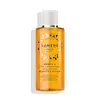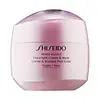What's inside
What's inside
 Key Ingredients
Key Ingredients

 Benefits
Benefits

 Concerns
Concerns

 Ingredients Side-by-side
Ingredients Side-by-side

Water
Skin ConditioningHamamelis Virginiana Leaf Water
AstringentGlycerin
HumectantBetula Alba Juice
AstringentPEG-40 Hydrogenated Castor Oil
EmulsifyingVaccinium Myrtillus Fruit Extract
Skin ConditioningRubus Chamaemorus Fruit Extract
AntioxidantRubus Chamaemorus Seed Extract
Skin ConditioningPhenoxyethanol
PreservativePropanediol
SolventAscorbyl Glucoside
AntioxidantSodium PCA
HumectantSaccharum Officinarum Extract
MoisturisingSodium Hydroxide
BufferingCitrus Aurantium Dulcis Fruit Extract
MaskingCitrus Medica Limonum Fruit Extract
Skin ConditioningMaltodextrin
AbsorbentEthylhexylglycerin
Skin ConditioningDisodium EDTA
Acer Saccharum Extract
Skin ConditioningSodium Citrate
BufferingPotassium Sorbate
PreservativeCitric Acid
BufferingSodium Hyaluronate
HumectantSodium Benzoate
MaskingLinalool
PerfumingLimonene
PerfumingParfum
MaskingWater, Hamamelis Virginiana Leaf Water, Glycerin, Betula Alba Juice, PEG-40 Hydrogenated Castor Oil, Vaccinium Myrtillus Fruit Extract, Rubus Chamaemorus Fruit Extract, Rubus Chamaemorus Seed Extract, Phenoxyethanol, Propanediol, Ascorbyl Glucoside, Sodium PCA, Saccharum Officinarum Extract, Sodium Hydroxide, Citrus Aurantium Dulcis Fruit Extract, Citrus Medica Limonum Fruit Extract, Maltodextrin, Ethylhexylglycerin, Disodium EDTA, Acer Saccharum Extract, Sodium Citrate, Potassium Sorbate, Citric Acid, Sodium Hyaluronate, Sodium Benzoate, Linalool, Limonene, Parfum
Water
Skin ConditioningDimethicone
EmollientDipropylene Glycol
HumectantGlycerin
HumectantSd Alcohol 40-B
AstringentHydrogenated Polydecene
EmollientPEG-10 Dimethicone
Skin ConditioningSorbitol
HumectantPEG-150
HumectantPEG-400
Emulsion StabilisingDiisostearyl Malate
EmollientPEG-9 Polydimethylsiloxyethyl Dimethicone
EmulsifyingDisteardimonium Hectorite
StabilisingPEG-20
HumectantTrehalose
HumectantPotassium Methoxysalicylate
BleachingPhenoxyethanol
PreservativePolyvinyl Alcohol
Hydroxyethylcellulose
Emulsion StabilisingButylene Glycol
HumectantTrisodium EDTA
Hdi/Trimethylol Hexyllactone Crosspolymer
Sodium Citrate
BufferingDipotassium Glycyrrhizate
HumectantAlcohol
AntimicrobialParfum
MaskingCaffeine
Skin ConditioningCitric Acid
BufferingSodium Metaphosphate
BufferingPEG/PPG-14/7 Dimethyl Ether
Skin ConditioningPPG-3 Dipivalate
Skin ConditioningLinalool
PerfumingTocopherol
AntioxidantCitronellol
PerfumingSodium Metabisulfite
AntioxidantGeraniol
PerfumingPaeonia Albiflora Root Extract
Skin ConditioningSilica
AbrasiveCI 77491
Cosmetic ColorantAngelica Keiskei Leaf/Stem Extract
Skin ConditioningLimonene
PerfumingCrataegus Monogyna Flower Extract
Skin ConditioningRehmannia Chinensis Root Extract
Skin ConditioningPrunus Yedoensis Leaf Extract
Skin ConditioningZiziphus Jujuba Fruit Extract
Skin ConditioningPyrola Incarnata Extract
Skin ConditioningPotentilla Erecta Root Extract
Skin ConditioningAchillea Millefolium Extract
CleansingBenzoic Acid
MaskingWater, Dimethicone, Dipropylene Glycol, Glycerin, Sd Alcohol 40-B, Hydrogenated Polydecene, PEG-10 Dimethicone, Sorbitol, PEG-150, PEG-400, Diisostearyl Malate, PEG-9 Polydimethylsiloxyethyl Dimethicone, Disteardimonium Hectorite, PEG-20, Trehalose, Potassium Methoxysalicylate, Phenoxyethanol, Polyvinyl Alcohol, Hydroxyethylcellulose, Butylene Glycol, Trisodium EDTA, Hdi/Trimethylol Hexyllactone Crosspolymer, Sodium Citrate, Dipotassium Glycyrrhizate, Alcohol, Parfum, Caffeine, Citric Acid, Sodium Metaphosphate, PEG/PPG-14/7 Dimethyl Ether, PPG-3 Dipivalate, Linalool, Tocopherol, Citronellol, Sodium Metabisulfite, Geraniol, Paeonia Albiflora Root Extract, Silica, CI 77491, Angelica Keiskei Leaf/Stem Extract, Limonene, Crataegus Monogyna Flower Extract, Rehmannia Chinensis Root Extract, Prunus Yedoensis Leaf Extract, Ziziphus Jujuba Fruit Extract, Pyrola Incarnata Extract, Potentilla Erecta Root Extract, Achillea Millefolium Extract, Benzoic Acid
Ingredients Explained
These ingredients are found in both products.
Ingredients higher up in an ingredient list are typically present in a larger amount.
Citric Acid is an alpha hydroxy acid (AHA) naturally found in citrus fruits like oranges, lemons, and limes.
Like other AHAs, citric acid can exfoliate skin by breaking down the bonds that hold dead skin cells together. This helps reveal smoother and brighter skin underneath.
However, this exfoliating effect only happens at high concentrations (20%) which can be hard to find in cosmetic products.
Due to this, citric acid is usually included in small amounts as a pH adjuster. This helps keep products slightly more acidic and compatible with skin's natural pH.
In skincare formulas, citric acid can:
While it can provide some skin benefits, research shows lactic acid and glycolic acid are generally more effective and less irritating exfoliants.
Most citric acid used in skincare today is made by fermenting sugars (usually from molasses). This synthetic version is identical to the natural citrus form but easier to stabilize and use in formulations.
Read more about some other popular AHA's here:
Learn more about Citric AcidGlycerin is already naturally found in your skin. It helps moisturize and protect your skin.
A study from 2016 found glycerin to be more effective as a humectant than AHAs and hyaluronic acid.
As a humectant, it helps the skin stay hydrated by pulling moisture to your skin. The low molecular weight of glycerin allows it to pull moisture into the deeper layers of your skin.
Hydrated skin improves your skin barrier; Your skin barrier helps protect against irritants and bacteria.
Glycerin has also been found to have antimicrobial and antiviral properties. Due to these properties, glycerin is often used in wound and burn treatments.
In cosmetics, glycerin is usually derived from plants such as soybean or palm. However, it can also be sourced from animals, such as tallow or animal fat.
This ingredient is organic, colorless, odorless, and non-toxic.
Glycerin is the name for this ingredient in American English. British English uses Glycerol/Glycerine.
Learn more about GlycerinLimonene is a fragrance that adds scent and taste to a formulation.
It's found in the peel oil of citrus fruits and other plants such as lavender and eucalyptus. The scent of limonene is generally described as "sweet citrus".
Limonene acts as an antioxidant, meaning it helps neutralize free radicals.
When exposed to air, oxidized limonene may sensitize the skin. Because of this, limonene is often avoided by people with sensitive skin.
The term 'fragrance' is not regulated in many countries. In many cases, it is up to the brand to define this term. For instance, many brands choose to label themselves as "fragrance-free" because they are not using synthetic fragrances. However, their products may still contain ingredients such as essential oils that are considered a fragrance.
Learn more about LimoneneLinalool is a fragrance and helps add scent to products. It's derived from common plants such as cinnamon, mint, citrus, and lavender.
Like Limonene, this ingredient oxidizes when exposed to air. Oxidized linalool can cause allergies and skin sensitivity.
This ingredient has a scent that is floral, spicy tropical, and citrus-like.
Learn more about LinaloolParfum is a catch-all term for an ingredient or more that is used to give a scent to products.
Also called "fragrance", this ingredient can be a blend of hundreds of chemicals or plant oils. This means every product with "fragrance" or "parfum" in the ingredients list is a different mixture.
For instance, Habanolide is a proprietary trade name for a specific aroma chemical. When used as a fragrance ingredient in cosmetics, most aroma chemicals fall under the broad labeling category of “FRAGRANCE” or “PARFUM” according to EU and US regulations.
The term 'parfum' or 'fragrance' is not regulated in many countries. In many cases, it is up to the brand to define this term.
For instance, many brands choose to label themselves as "fragrance-free" because they are not using synthetic fragrances. However, their products may still contain ingredients such as essential oils that are considered a fragrance by INCI standards.
One example is Calendula flower extract. Calendula is an essential oil that still imparts a scent or 'fragrance'.
Depending on the blend, the ingredients in the mixture can cause allergies and sensitivities on the skin. Some ingredients that are known EU allergens include linalool and citronellol.
Parfum can also be used to mask or cover an unpleasant scent.
The bottom line is: not all fragrances/parfum/ingredients are created equally. If you are worried about fragrances, we recommend taking a closer look at an ingredient. And of course, we always recommend speaking with a professional.
Learn more about ParfumPhenoxyethanol is a preservative that has germicide, antimicrobial, and aromatic properties. Studies show that phenoxyethanol can prevent microbial growth. By itself, it has a scent that is similar to that of a rose.
It's often used in formulations along with Caprylyl Glycol to preserve the shelf life of products.
Sodium Citrate is the sodium salts of citric acid. In skincare, it is used to alter pH levels and acts as a preservative.
Its main functions are to maintain the pH of a product and neutralize metal ions.
The acidity of our skin is maintained by our glands and skin biome; normal pH level of skin is slightly acidic (~4.75-5.5).
Being slightly acidic allows our skin to create an "acid mantle". This acid mantle is a thin barrier that protects our skin from bacteria and contaminants.
Learn more about Sodium CitrateWater. It's the most common cosmetic ingredient of all. You'll usually see it at the top of ingredient lists, meaning that it makes up the largest part of the product.
So why is it so popular? Water most often acts as a solvent - this means that it helps dissolve other ingredients into the formulation.
You'll also recognize water as that liquid we all need to stay alive. If you see this, drink a glass of water. Stay hydrated!
Learn more about Water